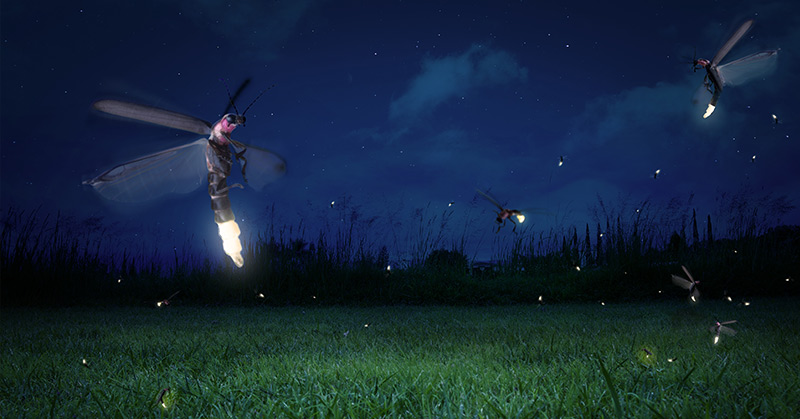Fireflies, also called lightning bugs, are little nocturnal winged insects the size of paper clips. Many people can spot them in warm environments and on summer evenings, often in humid regions in the Americas and Asia. Those who have never seen a firefly in person have been introduced to them by the character Ray in Disney’s Princess and the Frog, or through Owl City’s iconic song “Fireflies.”
How Do Fireflies Glow?
True to their name, fireflies gain their iconic glow from specialized organs in their abdomens. When the fly breathes in oxygen, these dedicated cells use it with a substance called luciferin to create light with minimal heat.
There are approximately 2,000 species of fireflies, and each one has its own light patterns that signal potential mates. Their light may also be a defense mechanism that warns predators of their unappetizing taste. Researcher have yet to discover how the fireflies turn their glow on and off. [1]
However, lightning bugs are at risk of being snuffed out.
Fireflies Facing Extinction
For those who have seen the magic of a firefly-lit night sky, and those who want to, are devastated to hear that fireflies made the United Nations list of one million species at risk because of human interference.
EcoWatch states that “by spraying toxic pesticides, polluting our air and water, degrading the landscape, and emitting ever more carbon, we’ve essentially captured nature in a big glass Mason jar, screwed the lid tight, and neglected to punch holes in the top.”
Nature’s beauty aside, losing fireflies would mean losing the chemicals found in their tails that can detect cancer and muscular dystrophy in humans.
In 2010, the Selangor Declaration issued a warning that stated the loss of fireflies is a sure sign the environment is in a bad state.
“Fireflies are indicators of the health of the environment and are declining across the world as a result of degradation and loss of suitable habitat, pollution of river systems, increased use of pesticides in agro-ecosystems and increased light pollution in areas of human habitation,” said the declaration. “The decline of fireflies is a cause for concern and reflects the global trend of increasing biodiversity loss.” [2]
“There just don’t seem to be as many fireflies around as there used to be.”
Sara Lewis is a biology professor at Tufts University and principal study author of “A Global Perspective on Firefly Extinction Threats” which was published in the journal Bioscience. She spent much of her career studying some species of fireflies’ mating rituals until she and her colleagues suddenly realized that “there just don’t seem to be as many fireflies around as there used to be.” [3]
They set out to research this issue, surveying scientists, conservationists, individuals involved in firefly tourism, and people who spent most nights watching these glowing insects.
“We basically asked them what they, personally, considered to be the most important threats to fireflies in their geographic region,” says Lewis. Habitat loss was number one that list, followed by light pollution and pesticide use.
Loss of habitat has been caused by coastal swamps being transformed into shrimp or palm oil farms, according to previous research. However, other species like the big dipper firefly seem to be still widespread.
“Lots of wildlife species are declining because their habitat is shrinking,” says Lewis, “so it wasn’t a huge surprise that habitat loss was considered the biggest threat.”
Light pollutions being the second-biggest issue came as a surprise to Lewis and her colleagues, but it does makes sense. Since firefly mating is based on flashes of light, anything that stops this light can be extremely problematic. East Asia and South America has ranked light pollution as the top threat for their firefly population.
“In addition to disrupting natural biorhythms — including our own — light pollution really messes up firefly mating rituals,” says study coauthor and Tufts Ph.D. candidate Avalon Owens. [4]
The issue of insecticide makes a lot of sense too. Fireflies are susceptible to being killed by pesticides, especially because they spend most of their lives close to the ground.
Other harmful issues include:
- Water pollution
- Tourism
- Overharvest
- Invasive species
- Climate change
Increasing Awareness
As bleak as this sounds, more research is required to establish what exactly is going on with fireflies and which species are the most at risk. Still, Lewis and her team work to raise awareness of this threat against lightning bugs.
After all, we can all agree that there is no excuse for fireflies’ extinction. They are not dangerous to humans; they can medically help people. They are small, require minimal resources, and create beautiful night spectacles anyone can enjoy.
“Fireflies are actually an insect that everybody can get behind,” Lewis says. [5]
Keep Reading: Expert Warns Trophy Hunting Could Push Polar Bears To Extinction
- Fireflies. National Geographic. https://www.nationalgeographic.com/animals/invertebrates/group/fireflies/
- Sara M. Lewis. A Global Perspective on Firefly Extinction Threats. BioScience. https://academic.oup.com/bioscience/article/70/2/157/5715071 February 2020
- Olivia Rosane. Fireflies Face Extinction From Habitat Loss, Light Pollution and Pesticides, Study Says. Eco Warch. https://www.ecowatch.com/fireflies-extinction-2645035259.html?rebelltitem=5#rebelltitem5 February 5, 2020[5] Kat Escher. Humans are putting fireflies at risk of extinction Popular Science. https://www.popsci.com/story/environment/firefly-extinction/ February 3, 2020

